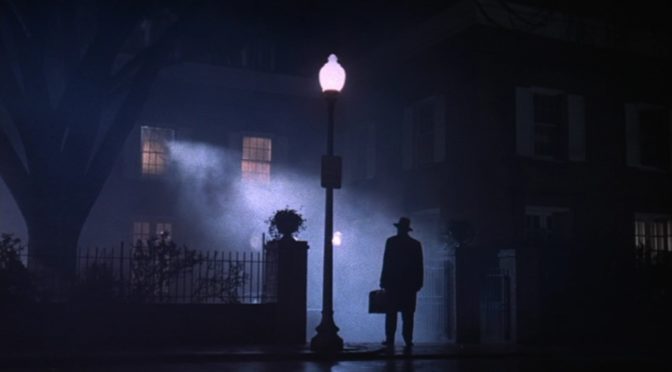“You’re going to die up there.”
The Exorcist might not have been the first film to wring fear out of comfortable Brownstone settings – the film is predated by Rosemary’s Baby – but it certainly perfected the art and the aesthetic. Like all horror films, The Exorcist traffics in the imagery of invasion and chaos, making its upper-crust Georgetown locales perfect. Few films have unsettled their audiences more.
The discomfiting effects start from the first frame. In a gorgeously shot prologue, Father Lancaster Merrin (Max von Sydow) discovers a stone likeness of the demon Pazuzu, a sequence straight of out of Lovecraft (echoes of the discovery of the bas relief in “The Call of Cthulhu”). Director William Friedkin, who won an Oscar two years before this for directing The French Connection, uses the ruins of northern Iraq to disorient the viewer through foreign language, music, ritual, and food. Not a word of English is spoken for the first fifteen minutes of the film. This works because Friedkin trusts the viewer – trusts them to stick with him for The Exorcist‘s slow-burn possession, trust them enough that we don’t see Merrin again for over an hour.
In many ways, The Exorcist breaks all the established rules of exorcism films. There is no real inciting incident; we don’t see Regan MacNeil (Linda Blair) reading an incantation or trespassing in a haunted house. Her possession seems arbitrary, which makes it even worse. The Exorcist is not afraid to embrace profanity, be it verbal or visual. Scenes that veteran horror watchers should be numb too still shock today, 43 years after the film’s initial release. There is the statue of the Virgin Mary, defaced with blood and a large phallus; Regan being shaken up and down on her bed, which looks undeniably sexual; Regan urinating on the carpet; masturbating with a crucifix; and the swearing – my God, the swearing! If it was a shock to hear Chloe Grace Moretz use the C-word in Kick-Ass, imagine what it must have been like to hear Linda Blair utter such obscenities in 1973. (“Your mother sucks cocks in hell” is one of the most effective film lines ever written.)
About Blair: a film like this, any film centered around a possession, lives and dies on the performance of the possessed. Blair’s performance here is so confident, so mature, and so fearless that it set the bar impossibly high for child actors (the best performance after hears is probably Haley Joel Osment in The Sixth Sense). The film rests on Blair’s shoulders, and it hasn’t aged a day. She holds her own, and commands the screen, even against warhorses like von Sydow and Ellen Burstyn (who plays Regan’s mother, movie actress Chris).
Also worth noting is the performance by Jason Miller as Father Damien Karras (both priests have names straight out of Gothic horror, in a great touch by screenwriter William Peter Blatty; one character even references Gothic classics Wuthering Heights and Northanger Abbey). Miller, a playwright who won the Pulitzer for That Championship Season while filming The Exorcist, plays Karras like a pugilist who’s taken two many haymakers to the breadbasket (I, uh, don’t watch boxing). The ease with which he doffs his collar, or lets it hang askew, suggests a complicated relationship with his faith, and in one of the film’s most clever touches, he advises Chris against an exorcism.
Of course, any film called The Exoricst build towards the actual exorcism, which Friedkin stages as a grotesque ritual that takes up the last twenty-five minutes of the film. The muted sterility of the MacNeil home is used to terrific effect: Regan’s room is sparsely decorated, and her bedroom takes up most of it. It looks like a hotel room – anonymous – which adds to the arbitrary nature of her possession. Bound to the bed, her posture may be submissive, but she dominates the scene.
The exorcism is a rightfully classic sequence. One of the film’s scariest shots, when the viewer gets a glimpse of the full scope of Pazuzu’s hellish power, is Regan levitating helplessly off the bed while Merrin and Karras recite scripture (this also leads to the immortal line “The power of Christ compels you!”). The stakes are real: only when the priests arrive does Chris allow herself to consider that her daughter might die, and the exorcism itself claims the lives of both Merrin and Karras (the latter gets possessed himself and throws himself out of the window).
Re-watching The Exorcist, it’s remarkable how well it holds up, which feels like such an obvious, mundane statement that it’s barely worth typing. What’s even more remarkable is how it flouts the conventions of copycat films that it largely inspired. Films about exorcisms will never end, and some of them are even good (I think The Conjuring is terrific). But they’ll never be this smart again. Or this confident. Or this flawless.
10/1: Dawn of the Dead (2004)
10/2: The Exorcist
10/3: Pontypool
10/4: Hocus Pocus
10/5: The Orphanage
10/6: Rosemary’s Baby
10/7: Alien
10/8: Scream series
10/9: Scream series
10/10: Cujo
10/11: The Cabin in the Woods
10/12: Pulse
10/13: The Babadook
10/14: Friday the 13th
10/15: The Last House on the Left (both versions)
10/16: The Thing (both versions)
10/17: Little Shop of Horrors
10/18: Hush
10/19: Silent Hill
10/20: The Shining
10/21: Funny Games
10/22: Evil Dead series
10/23: Evil Dead series
10/24: The Mist
10/25: The Ninth Gate
10/26: The Fly
10/27: A Nightmare on Elm Street
10/28: The Nightmare Before Christmas
10/29: 28 Days Later/28 Weeks Later
10/30: It
10/31: Halloween


